|
How
can the Nationals be "reborn" in 1946? It seems like it would have just
recently been born in the first place in 1946. Here is a passage
from the
Academy of Model Aeronautics' history page: "Before the Academy
of Model Aeronautics (AMA) came into existence, aeromodelers belonged
to a variety of organizations, including the Junior Air League, the
Junior Aviation League, and the Junior NAA (the aeromodeling branch
of the National Aeronautic Association.) The Junior NAA, although sponsoring
the first “National Aeromodeling Championships” (Nats) in 1923, struggled
to be a true aeromodeling organization. The idea for the AMA began in
1935 (perhaps even before that) at the National Championships in Detroit,
Michigan." Prior to the 1946 Nats reported on in this issue of Air Trails,
the last Nats was held in 1941 - 5 years hence, evidently interrupted
by WWII. The Nationals Reborn
By Charles H. Grant

On Monday, August 26th, we passed through the welcome doors of the
Hotel Allis, Wichita, Kansas, to start our great adventure at the 15th
National Model Airplane Contest. The Allis was one of three hotels assigned
to contestants, leaders, and representatives of the model events ; the
Lassen Hotel was five blocks away, the Broadview about ten.
Early the following morning, contest officials greeted us warmly at
the Wichita Forum, headquarters for the National Contest. They were
rushing to complete the final organization details. Quiet, but efficient,
Al Hummel, had managed the organization of the contest in record time.
In less than six weeks he, with an efficient group of helpers, had completed
and gotten together the thousands of details necessary to stage this
great classic. Jim McClelland, director of the contest, was responsible
for the technical details. The members of the two sponsoring organizations,
the Wichita Y.M.C.A. and the Kiwanis Club, had worked under this leadership
with zeal.
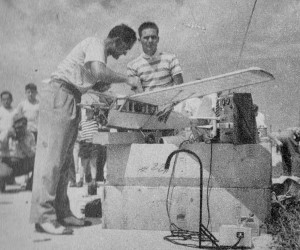
Jim Walker gives his Radio Control model a final check before a
flight.

Dave Slagle, who amazed the expert with his fine stunt flying.

Berryloid Trophy went to Tex Russell. His model was as beautiful
as it was different.
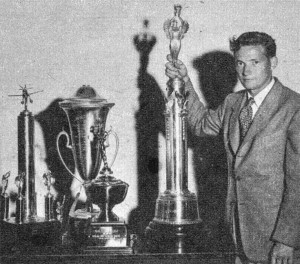
Milton Hugelot, National champion.

Jim Walker, winner of Radio Control Trophy.
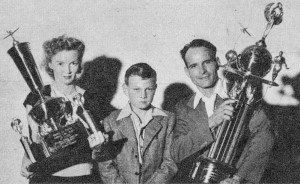
May, Dave, and H. Slagle. Dave was Flying Champ in all stunt classes.

Al Orthof presents Air Trails Pictorial Trophy to "Wally" Wallick,
winner of Class VI Speed, Open.

Bop Tagle presents Micro Bilt Trophy to Frank Davis.
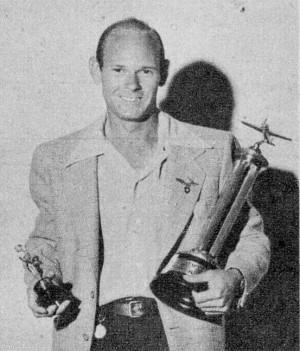
Bill Atwood, manufacturer of Atwood Engine, wins indoor trophy.
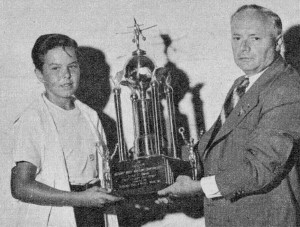
David Wade receives Herkimer Trophy from Chas. Brebeck.
Besides the,hotels, a tourist camp was made available for housing
contestants. Work shops were established in the spacious Wichita Forum
building and at the nearby Y.M.C.A. The Y.M.C.A. also provided recreation
facilities, and, for those who had time, interesting tours of the city
were made available. Contest officials met for a final briefing at the
Y.M.CA. on Tuesday evening. A gadget which they developed for measuring
the wing area of models was unique. It consisted of a long rod with
a knife blade at one end and a long, sharpened wire at the other, .
A special room at another branch of the Y.M.C.A. housed the prizes,
and resembled the store-room of some large hardware company, what with
gleaming bright columns, globes, triangles, figures, airplanes, and
other gilded fantasies on every hand. No other national contest offered
so many awards (there were over five hundred). On Wednesday,
contestants, leaders, and industry members arrived in ever increasing
numbers. It was a great moment for many who had not seen their buddies
since the previous Nationals in 1941. In fact, the 1946 Nationals proved
to be not only a contest but a great convention of the whole model field
as well. At noon, Thursday, the line of registrants extended
through the Forum doors and far down the street, while volunteer workers
recorded contestants' names, the events, the types of models, and other
details. In the evening, contestants were briefed for their coming ordeals
- in the Forum Arena where indoor ships were to compete; at Rawdon Field,
seven miles east of Wichita, where the outdoor events were to take place;
or at Boeing Ramp, a broad stretch of concrete nearly half a mile long,
if they were flying control-line or radio control planes. On
Friday, indoor events started at 8:00 a.m. Ships were processed at the
Arena and hand-launch gliders of every imaginable design filled the
air for about three hours, which then were replaced by the hand-launch
stick ROG, cabin and ROW cabin events, There was also an event for new
types of aircraft: autogiros, helicopters, and ornithopters - or combinations
of these, On Friday afternoon, we "rattled" to the ROW contest
in a hired car and finally arrived at the. contest site, Crestview Lake,
about five miles out of town. Crowds lined the shore; whining motors
gave the impression that a swarm of bees was descending for "the kill."
Various designs were tuning up for flights. A twin-float "Zipper" was
the first to leave the water after several unsuccessful trials by other
contestants. Lack of experience in ROW flying was evident, but persistence
on the part of the contestants, combined with power dives into the water,
cartwheels, and low flights over the crowd provided a show equal to
any previously staged. Planes with short floats and ample planing area
were the most successful. Planes tripped by Father Neptune before taking
off the water were retrieved by two Boy Scout helpers in a row boat.
Flights continued until dark. Those who flew early were fortunate because
later the air cooled and thermals died, resulting in much shorter flights.
On this same afternoon the control-line stunt, control-line speed, and
radio control events started at the Boeing Ramp. These were scheduled
for the four clays of the contest. Friday evening, the contest
board of the AM.A held a rules committee meeting at the Y.M.C.A while
contestants repaired and prepared their models for the next clay's events.
The class "A" Gas Free Flights started early at Rawdon Field, Saturday
morning, in brilliant sunshine, while a strong wind blew models into
the dim distance as fast as they were launched. Fortunately, in spite
of the wind many thermals carried these little ships to considerable
altitude. ROG rubber-powered models also provided an excellent show
for the spectators and other contestants who lined the restraining ropes.
An outstanding flight was made by a plane of unique design - a Canard
pusher. This little plane outflew nearly every other cabin job on the
field. The field was laid out in the usual manner. In the gas event,
pylon types predominated but didn't necessarily excel in flight. The
steadiest flights were made by non-pylon original designs, the Canard
pusher being an outstanding example. At 7 :30 that evening, contestants
flocked to the Berryloid finish and flying scale events at the Forum.
The Berryloid event was won by Tex Russell with a model notable not
only for its finish but for its unusual shape. It was a "tailless" control-line
ship with tapered wings swept forward. Its glass-like finish and polished
metal trimmings gave it the appearance of some brilliant jewel. It was
selected as winner without question, though many other models of fine
workmanship competed. The flying scale models appeared to be larger
than usual with light delicate construction. Sunday, at Rawdon
Airport, Class "B" free-flight planes were chasing thermals all over
the sky. Many stiff necks were caused by following one model which persisted
in remaining aloft for over thirty minutes. Rubber-powered stick models
also put on a show, and of the two classes the rubber jobs were much
more stable and turned in better flights. Pylon gas models predominated,
but there were a few original designs of interest. Pat Massey's plane
with Vee-tail and gull wings pleased the crowd with its consistently
steady flying. Autogiro, helicopter, and ornithopter events brought
further fantastic designs which flew well. Kansas had voted dry, but
the weatherman apparently objected to this decision because about 1:00
o'clock dark clouds appeared on the horizon and chased the sunshine
to parts unknown. Almost before the model builders could get the models
under cover and close their tool boxes the rain descended. We usually
think of rain as dropping, but Kansas rain is different; it attacks
from all directions - down, up, and sideways. The flying field was dry
and sunbaked one minute; the next it was appropriate for row boats.
Models were soaked, timers' tents leveled, and cars hopelessly mired
in three inches of water. Fortunately, most of the contestants had cars
at the field into which they ducked for cover. Believe it or not, one-half
hour later the sun came out and models were in the air again. Many of
the best times of the day were made later in the afternoon. At·Boeing
Ramp, after the storm, control-line ships tore through the air from
90 to 116 mph. One of the outstanding contestants was Dave Slagle -
a thirteen-year-old lad from Burbank, Calif. He put to shame all other
contestants, some of whom were experts. In the stunt event he whipped
his plane through every possible maneuver - s-dives, loops, rolls, and
upside-down flights. His performance was largely due to graceful footwork
and a sense of rhythm.
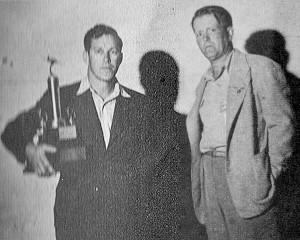
Dick Korda (holding trophy) and Walt Schroder.
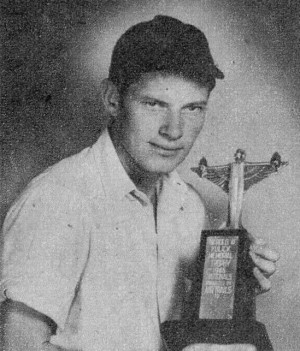
J. H. Brown holds Air Trails Pictorial-sponsored Kulick Memorial
Trophy.
The Air Trails Pictorial Trophy went to C. H. Wallick, of California,
for winning the greatest number of points in the U-control speed events.
Monday, September 2nd, produced fine weather for class "C" jobs
during the morning. Spectators saw many ships fly out of sight; others
disappeared in puffy douds. Hand-launch and tow-line gliders provided
fine shows. About noon, however. a strong, cool wind blew up that made
flying difficult and hazardous. This continued until late in the day.
Times were naturally low because models flew out of sight quickly.
Early in the morning, Jim Walker won the radio control event
by putting his entry through some complex maneuvers, including take-offs,
circles, figure eights, and spot landings. The. Victory, Buffet
supper at the forum contributed by the Wichita Women's Aeronautic Association,
crowded the five days of activity. It was attended by contestants. officials,
and others connected with the meet. Immediately afterward, everyone
adjourned to the Forum Arena for the presentation of prizes and a few
short talks by A.M.A. officials and contest sponsors. Before prizes
were distributed, honors, including fellowships in the A.M.A., were
bestowed upon several leaders and model flyers whose contributions have
been outstanding to model aviation. They were Carl Goldberg, Dr. Walter
Good, William Good, Irving Levy, Jim Walker. and Charles Grant.
After this, more than five hundred prizes were distributed. One
junior flyer won so many trophies he required two assistants to carry
them. At this final meeting, leaders and contestants had a chance to
get together on a friendly basis and discuss their problems. Some of
the old-timers present were Leo Rutledge; Frank Nekimken, director of
former Nationals; Carl Goldberg; Walt Schroder; Ed Lidgard; Lewis Casale;
Dick Korda; Milton Huguelet, who won the National Championship for the
second time; Alan Orthof, Editor of Air Trails Pictorial, and other
famous modelers. Mr. Al Lewis, Director of the A.M.A., directed the
meeting with his usual grace and humor, without which no National competition
would be complete. In attendance, was the only woman official, Miss
Marjorie Thacker, who served as timer for three days. Her talents were
made available through the courtesy of the Beech Aircraft Company for
whom she serves as aerodynamist. The contest was enjoyed by everyone,
in spite of the short time allowed for its preparation, and the sponsors
are to be complimented on their untiring efforts in organizing and running
it.
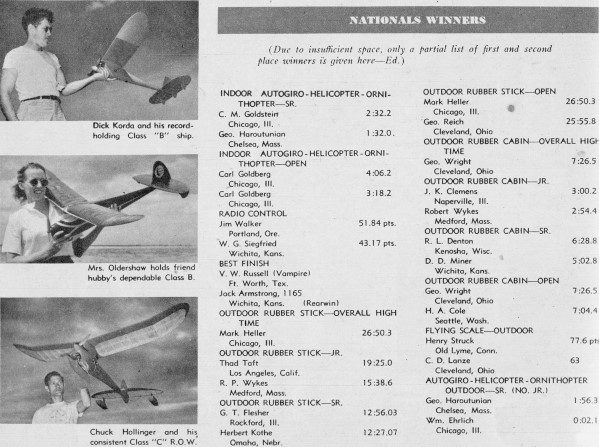
Dick Korda and his record-holding Class "B" ship.
Mrs. Oldershaw holds friend hubby's dependable Class B. Chuck Hollinger
and his consistent Class "C" R.O.W.
Posted April 21, 2012
|